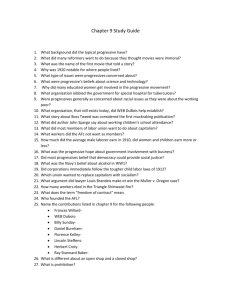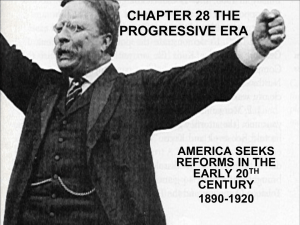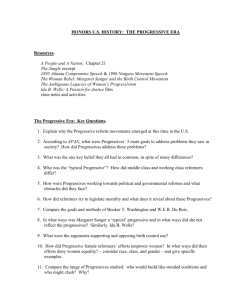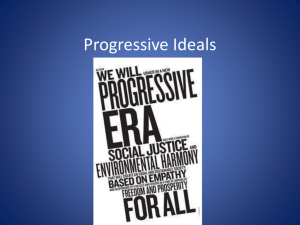The Progressive Era, 1900-1917 Lecture-Reading Notes 2 (p. 141-150) II. Trans-Atlantic Influences
advertisement
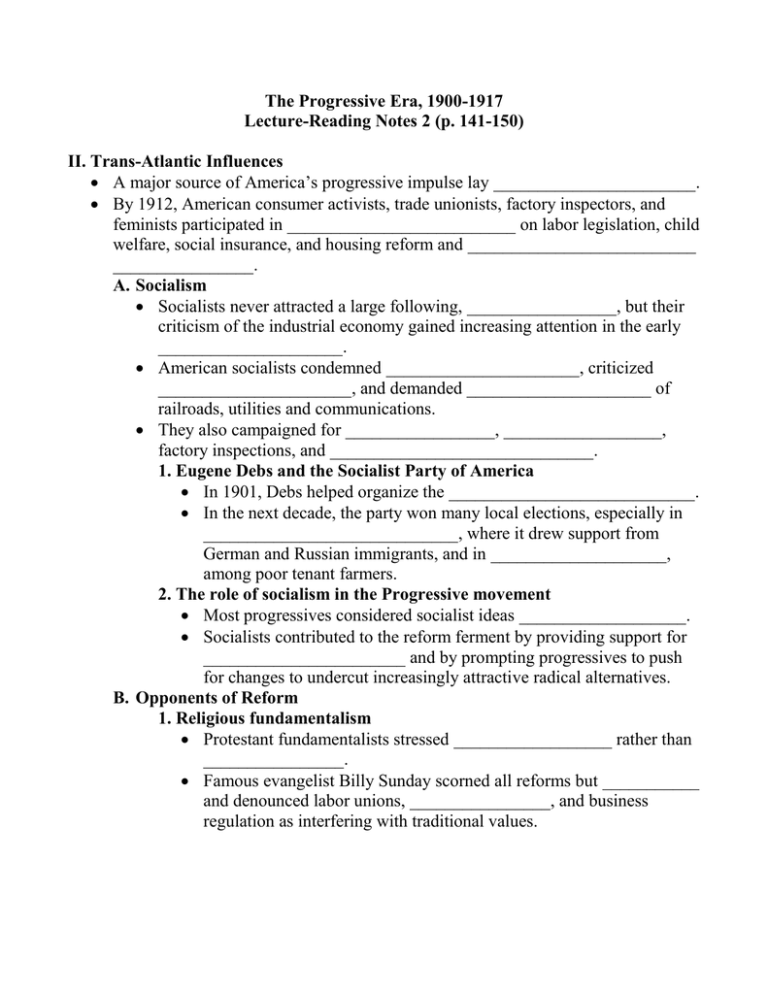
The Progressive Era, 1900-1917 Lecture-Reading Notes 2 (p. 141-150) II. Trans-Atlantic Influences A major source of America’s progressive impulse lay _______________________. By 1912, American consumer activists, trade unionists, factory inspectors, and feminists participated in __________________________ on labor legislation, child welfare, social insurance, and housing reform and __________________________ ________________. A. Socialism Socialists never attracted a large following, _________________, but their criticism of the industrial economy gained increasing attention in the early _____________________. American socialists condemned ______________________, criticized ______________________, and demanded _____________________ of railroads, utilities and communications. They also campaigned for _________________, __________________, factory inspections, and ______________________________. 1. Eugene Debs and the Socialist Party of America In 1901, Debs helped organize the ____________________________. In the next decade, the party won many local elections, especially in _____________________________, where it drew support from German and Russian immigrants, and in ____________________, among poor tenant farmers. 2. The role of socialism in the Progressive movement Most progressives considered socialist ideas ___________________. Socialists contributed to the reform ferment by providing support for _______________________ and by prompting progressives to push for changes to undercut increasingly attractive radical alternatives. B. Opponents of Reform 1. Religious fundamentalism Protestant fundamentalists stressed __________________ rather than ________________. Famous evangelist Billy Sunday scorned all reforms but ___________ and denounced labor unions, ________________, and business regulation as interfering with traditional values. 2. Business interests Major corporations like Standard Oil created ___________________ to improve their image and to identify business, not its critics, with the public interest. The courts aided employers by _______________________________ and prohibited unions from using boycotts, one of their most effective weapons 3. Supporters of laissez-faire conservatism Many Americans objected to what they considered unwarranted interference in ___________________________. In Lochner v. New York (1905), the Supreme Court overturned a maximum-hours law on the grounds that it deprived employers and employees of their “_____________________.” III. Reforming Society A. Settlement Houses and Urban Reform The spearheads for social reform were ______________________, community centers in urban immigrant neighborhoods. Most settlements were led and staffed primarily by _________________ ___________________. Settlement workers organized ____________________________; taught classes in _________________, cooking and personal hygiene; held musical performances and poetry readings; _______________________. Settlement workers soon saw that the root problem for immigrants was __________________ that required more changes in individual behavior. Settlement workers campaigned for stricter building codes to improve slums, better sanitation systems to enhance public health, public parks to revive the urban environment, and laws to ________________________. In 1901, the ________________________________ became a model for other cities. B. Protective Legislation for Women and Children 1. Child labor The ______________________ of children in industrial accidents made it “inevitable,” Jane Addams said, “that efforts to secure a child labor law should be our first venture into the field of state legislation.” Reformers met stiff resistance from __________________who used child labor, _____________________ who opposed government action as an intrusion into family life, and ______________________ who needed their children’s income. By 1914, every state but _________ had a minimum working age law. 2. Labor laws for women Social reformers also lobbied for laws regulating the ___________, ________, and _______________ of women and succeeded in having states from New York to Oregon pass maximum-hours legislation. Fewer states established minimum wages for ________________. Progressive Era lawmakers limited protective legislation to measures reflecting the belief that women needed _______________________, even _____________________ them from certain occupations. Protective legislation thus assured women not economic independence but continued __________________________ on husbands or fathers. 3. Origins of the welfare state Social justice reformers forged the beginnings of the _____________, as many states began in 1910 to provide “mothers’ pensions” to indigent widows with dependent children. Twenty-one states, led by Wisconsin in 1911, enacted ____________ _____________________ programs. Proposals for _______________________ and __________________ programs went nowhere. C. Reshaping Public Education Concerns about child labor overlapped with increasing attention to public schools. In 1900, women’s clubs in North Carolina launched a program to _____________________________, increase teachers’ salaries, and broaden ____________________________. Between 1880 and 1920, ___________________________, kindergartens, age-graded elementary schools, ___________________________, vocational education, parent teacher associations, and school nurses became standard elements in American education. Public education in the South lagged behind the North. After 1900, per capita expenditures for education doubled, school terms were extended, and high schools spread across the region. But the South frittered away its limited resources on a _____________________________ that shortchanged both races. South Carolina spent _______________ times as much per white pupil as per black pupil. D. Challenging Gender Restrictions 1. Margaret Sanger and the birth control movement Sanger saw in New York’s immigrant neighborhoods the plight of poor women worn out from ______________________ or injured or dead from self-induced _____________________________. Despite federal and state laws against contraceptives, Sanger began promoting ___________________ as a way to avert such tragedies. Sanger declared, “Women cannot be on equal footing with men until they have full and complete control over their __________________.” 2. The National Birth Control League Sanger’s crusade infuriated those who regarded birth control as a threat to ___________________________. Indicted for distributing information about ________________, Sanger fled to Europe. Other women took up the cause, forming the ____________________ ___________________ in 1915 to campaign for the repeal of laws restricting access to contraceptive information and devices. E. Reforming Country Life Progressives worked to improve _____________ and ____________and to replace inefficient one-room schools with modern consolidated ones under professional control, and to extend _______________ and communication services into the countryside. President Theodore Roosevelt created the __________________________ in 1908. Agricultural scientists, governmental officials, and many business interests also sought to promote ______________, _________________ and _______________________ agriculture. A key innovation was the county agent system: the ____________________ _____________ and business groups placed an agent in each county to teach farmers new techniques and encourage changes in the rural social values that had spawned the Populist radicalism that most progressives decried. Few farmers welcomed these efforts. _________________________ meant the loss of community control of education; _________________ would raise taxes and chiefly benefit urban business interests. Government agencies, agricultural colleges, and railroads and banks steadily tied farmers to _______________________. F. Social Control and Moral Crusades The tendency toward ____________________ evident in the movements to pass protective legislations and transform country life also marked other less attractive progressive efforts. These efforts often meshed with restrictive attitudes that conservative Americans held about __________, _____________, ________________ and ___________. Native agitation in California prompted the federal government to restrict ______________________ immigration in 1907. Californians, including local progressives, also hoped to curtail the migration of ________________________. Nationally, public debate focused on _________________________ of new immigrants from southern and eastern Europe. The Daughters of the American Revolution sought to inculcate __________, ________________, and ________________________. _____________________ and ________________________ attempted to transfer their own values to the newcomers. In 1915, Frances Kellor helped organize the __________________________ _________________ and increasingly emphasized destroying immigrants’ old-country ties and imposing an American culture. __________________ saw liquor as a cause of crime, poverty, and family violence; ____________________ blamed it for causing industrial accidents and inefficiency; Social Gospel ____________________ condemned the “spirit born of hell” because it impaired moral judgment and behavior. Protestant fundamentalists also stoutly supported ______________, working through the ____________________________, founded in 1893. Eventually, the _____________________________ made prohibition the law of the land by 1920. Less controversial was the drive to control ________________, then readily available, and _______________. Congress passed the ____________________________, which prohibited the distribution and use of narcotics except for medical purposes. The progressive attack on prostitution resulted in state and city attacks on “red light” districts and the federal ________________________, which banned the interstate transport of women “for immoral purposes.” California’s state assembly prohibited ______________, ______________, and ________________, and Los Angeles banned premarital sex and introduced artistic censorship. G. For White People Only? In the South, progressivism was built on black __________________ and _________________. Antiblack race riots and ___________ – defended on the floor of the United States Senate by a Southern progressive – were part of the system of ______ ______________that made the era a terrible time for African Americans. Even in the North, where relatively few black people lived, _____________ ________________________. ___________________, campaigned tirelessly against all forms of racial discrimination. In 1905, Du Bois and other black activists met in Niagara Falls, Canada, to make plans to promote ____________________________. In 1910, this _____________________, joined with a small group of white reformers, including Jane Addams, to organize the ____________________ ______________________________. The NAACP sought to overthrow segregation and establish equal justice and educational opportunities.
